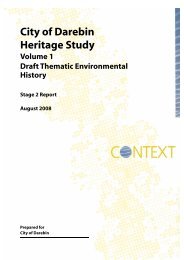INDUSTRIAL LAND USE STRATEGY - City of Darebin
INDUSTRIAL LAND USE STRATEGY - City of Darebin
INDUSTRIAL LAND USE STRATEGY - City of Darebin
Create successful ePaper yourself
Turn your PDF publications into a flip-book with our unique Google optimized e-Paper software.
4.5 Contributions toDevelopmentCouncil recognised the need to seekcontributions toward the cost <strong>of</strong> theprovision <strong>of</strong> social and physicalinfrastructure incorporating the followingstrategy into the Municipal StrategicStatement in 1999:“Measure the impact <strong>of</strong> newdevelopment and, whereappropriate, require developers tocontribute to additional oraugmented social/physicalinfrastructure.”Council now needs to consider the range<strong>of</strong> mechanisms available to attractcontributions for the renovation <strong>of</strong>streetscapes, provision and upgrading <strong>of</strong>social and cultural infrastructure and thedevelopment <strong>of</strong> an attractive andsustainable environment.Traditional industrial areas have poor orno green space and a very low level <strong>of</strong>amenity with streetscapes dominated bythe provision <strong>of</strong> overhead services,parking, storage <strong>of</strong> materials and wastestorage and no setbacks.Redevelopment <strong>of</strong> identified redundantindustrial buildings and areas is expectedto yield considerable dwellingopportunities and increase residentialdensities. Redevelopment <strong>of</strong> industrialsites/areas for <strong>of</strong>fice purposes can alsohave a similar impact on local servicesintroducing potentially substantialworkforces who require access to localfacilities and a higher level <strong>of</strong> amenity.Some <strong>of</strong> these sites present substantialdevelopment opportunities and this willlead to an increase in demand for existingfacilities and perhaps, where ademographic is substantially impacted,may result in a demand for new facilities.If more sensitive uses are to bepermitted in some <strong>of</strong> the industrialareas, then Council will have toimprove the level <strong>of</strong> amenity inthese areas.Works necessary may includeimprovements such as:• Provision <strong>of</strong> parkland/green spacesor upgrading <strong>of</strong> nearby parks• Planting <strong>of</strong> street trees• Undergrounding (or overheadbundling <strong>of</strong> cable) <strong>of</strong> powersupplies• Rationalization <strong>of</strong> street poles• Roadworks – eg trafficmanagement works• Community and multi-culturalfacilities• Expansion/construction <strong>of</strong> socialinfrastructure such as maternalhealth, aged care, child-carefacilities etc.• Improvements to sewerage anddrainage systems.Improvements such as the upgrading <strong>of</strong>a child care facility would have abenefit to a segment <strong>of</strong> the widercommunity whereas the benefit <strong>of</strong>planting <strong>of</strong> street trees would beconfined to a more immediate locale.Substantial upgrading <strong>of</strong> the existinginfrastructure will be required ifCouncil allows the conversion <strong>of</strong> someindustrial areas for non-industrial uses.Ultimately the responsibility andthus the cost for upgrading thisinfrastructure rests with Council.Council can seek contributions fromdevelopers and the community to fundthese improvements via a number <strong>of</strong>techniques as discussed below.Industrial Land Use Strategy 17
















